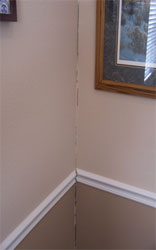
What makes Soils Unstable?
Certain conditions in the soil can cause foundation movement and consequent foundation or structural damage.
In granular soils (sand, gravel) movement often results from a condition in which there are too many voids between particles. A good mixture of particle size normally will increase stability.
Some types of silt deposits are held together because of particle bonding or cementing minerals. These soils may be susceptible to collapse if exposed to excessive amounts of water. These soils are called Hydro-collapsible Soil.
A dramatic type of failure occurs in areas of so-called Expansive Clays. These soils are prone to large volume changes related to moisture content. They shrink in dry seasons; swell in wet seasons or when otherwise in the presence of water, thus causing massive damage to structures and pavements.
Ground freezing is responsible for soil expansion due to "frost heave." Soil deposits containing silts are very prone to severe frost heave. Expansion caused by frost heave is great enough to lift even heavily loaded foundations and slabs.
Some causes of soil movement are predictable. Other causes of soil movement are less predictable. Earthquakes have an obvious effect on the building system. Foundations typically are designed to support downward vertical load. However, ground shaking during an earthquake produces horizontal forces. Designs for earthquake prone zones must be accounted for as well. Deposits of loose sand in these areas can also create further problems as the intense shaking may cause the soil to "liquefy."
Certain types of movement are entirely preventable. Before a building foundation is constructed, any fill soil should be properly placed and compacted. There should be no organic material (i.e. tree stumps or construction debris) in the soil. These will decay over time, leaving voids that result in unstable conditions.
Underground water has been known to cause severe problems. When a foundation is built on a site, it may interfere with the natural flow of groundwater. Buildings may even be built over aquifers or seasonal flows. The erosive nature of moving water is well known and voids or excessive pressure builds-ups are possible.
Basement walls can shift, crack and possibly collapse as a result of poor foundation soils or because of lateral pressures caused by soil and groundwater on the wall exterior. Concrete floor slabs can crack if the supporting soil settles, expands or lifts.
Densifying the soil to minimize settlement potential.